
HTTP/1.1 Fatal Vulnerability Exposes Millions of Websites to Hostile Takeover
A silent, fundamental flaw within the aged yet ubiquitous HTTP/1.1 protocol now poses a critical threat to millions of websites. This decades-old ambiguity at the very core of web communication creates an extreme opportunity for malicious actors to orchestrate sophisticated desynchronization attacks, leading to potential hostile takeovers of entire online infrastructures. Understanding this vulnerability and its implications is paramount for any organization reliant on web services.
The HTTP/1.1 Vulnerability Explained: Desynchronization Attacks
The essence of this critical HTTP/1.1 vulnerability lies in its parsing ambiguity. When web servers and proxies interpret requests, there can be subtle differences in how they determine where one HTTP request ends and the next begins. This phenomenon, known as HTTP request desynchronization or HTTP request smuggling, allows an attacker to “smuggle” a second, malicious request within a legitimate one. The front-end server (e.g., a load balancer or reverse proxy) might process only the first part of the request, forwarding the remainder as the start of a new, attacker-controlled request to the backend server.
This desynchronization creates a critical window for hostile takeovers. An attacker can manipulate web traffic, bypass security controls, access sensitive information, or even compromise entire web application infrastructures by injecting unauthorized requests that the backend server wrongly attributes to a legitimate user or session.
Impact and Scope: Millions of Websites at Risk
Given the pervasive nature of HTTP/1.1, the scale of this vulnerability is staggering. Tens of millions of websites, from small businesses to large enterprises, are potentially exposed. Any website utilizing a proxy server, load balancer, or content delivery network (CDN) in front of its origin server is susceptible, as these configurations are prime environments for desynchronization discrepancies.
The potential consequences of a successful desynchronization attack include:
- Bypassing Security Controls: Attackers can bypass web application firewalls (WAFs), authentication mechanisms, and access control lists.
- Session Hijacking: Unauthorized access to user sessions, leading to data breaches or account takeovers.
- Cache Poisoning: Injecting malicious content into web caches, affecting all subsequent users.
- Cross-Site Scripting (XSS): Delivering persistent XSS attacks to unsuspecting users.
- Internal Network Access: Potentially gaining access to internal resources behind the proxy.
- Data Exfiltration: Stealing sensitive data from backend systems.
- DDoS Attacks: Leveraging the infrastructure for distributed denial-of-service attacks.
While specific CVE numbers for this overarching architectural flaw are complex due to its fundamental nature, individual server and proxy implementations that incorrectly handle HTTP/1.1 parsing have seen related vulnerabilities, such as those that might fall under categories like CVE-2019-11043 (PHP-FPM NGINX RCE related to HTTP request smuggling) or various vulnerabilities associated with HTTP header parsing discrepancies.
Remediation Actions for Web Administrators and Developers
Mitigating the risk of HTTP/1.1 desynchronization attacks requires a multi-faceted approach, focusing on consistent HTTP parsing across all components of your web architecture.
- Standardize HTTP Parsing: Ensure that all components in your web stack (load balancers, proxies, web servers) use a consistent and strict interpretation of HTTP/1.1 specifications, particularly regarding
Content-LengthandTransfer-Encodingheaders. - Disable HTTP/1.1 Pipelining: While HTTP pipelining can offer performance benefits, it significantly complicates parsing and can increase the risk of desynchronization. Disable it if not strictly necessary.
- Upgrade to HTTP/2 or HTTP/3: Where possible, migrate to newer HTTP versions (HTTP/2 or HTTP/3). These protocols use multiplexing and binary framing, which inherently reduce the ambiguities present in HTTP/1.1 text-based parsing, making desynchronization attacks far more difficult or impossible.
- Strict Header Validation: Implement stringent validation for HTTP headers, particularly
Content-LengthandTransfer-Encoding. Reject requests that contain both headers or malformed versions. - Normalize Requests: Configure your frontend proxies to normalize HTTP requests before forwarding them to backend servers. This includes removing questionable headers or enforcing specific parsing rules.
- Patch and Update: Regularly update all web servers, proxies, load balancers, and WAFs to their latest versions. Software vendors often release patches to address specific parsing vulnerabilities.
- Web Application Firewalls (WAFs): Deploy and properly configure a WAF to detect and block suspicious HTTP request patterns indicative of desynchronization attempts. Ensure the WAF is capable of deep packet inspection.
- Rate Limiting and Anomaly Detection: Implement tools to detect unusual request patterns, high error rates, or abnormally long request queues that might signal an ongoing attack.
Essential Tools for Detection and Mitigation
Leveraging specialized tools can significantly aid in identifying and mitigating potential HTTP desynchronization vulnerabilities within your infrastructure.
| Tool Name | Purpose | Link |
|---|---|---|
| Burp Suite (PortSwigger) | Manual and automated testing for HTTP request smuggling, comprehensive web vulnerability scanning. | https://portswigger.net/burp |
| HTTP Request Smuggler (Tool specific) | A Burp Suite extension designed specifically for detecting HTTP Request Smuggling vulnerabilities. | https://portswigger.net/bappstore/ea41cb6982634be78864756c52dedc90 |
| Nmap (with Http-enum script) | Network scanning and service enumeration; can help identify web server versions (though not direct smuggling detection). | https://nmap.org/ |
| OWASP ZAP | Open-source web application security scanner, includes various testing capabilities, can assist in general HTTP anomaly detection. | https://www.zaproxy.org/ |
| WAF Solutions (e.g., ModSecurity, Cloudflare WAF) | Web Application Firewalls designed to filter and block malicious web traffic, including potential smuggling attempts. | https://modsecurity.org/ (ModSecurity) https://www.cloudflare.com/waf/ (Cloudflare) |
Conclusion: Strengthening Web Defenses Against Fundamental Flaws
The discovery of critical HTTP/1.1 vulnerabilities underscores the importance of scrutinizing even the most fundamental components of our digital infrastructure. This flaw, rooted in HTTP/1.1’s parsing ambiguity, presents a clear and present danger of hostile takeovers through sophisticated desynchronization attacks. Protecting against this threat demands immediate attention to consistent HTTP parsing across all architectural layers, aggressive patching, and strategic adoption of newer, more robust protocols like HTTP/2 and HTTP/3.
For IT professionals and security analysts, the directive is clear: proactively assess your web application stack, identify potential desynchronization points, and implement the necessary remediation actions to safeguard your digital assets and user data. Continuous vigilance and adherence to security best practices remain the strongest defense against evolving web vulnerabilities.





